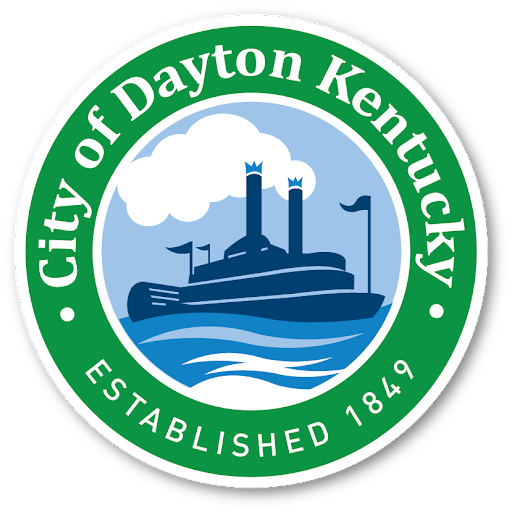Over the years, the Ohio River has been a key resource, an economic driver, and a natural challenge for the City of Dayton.
During its pre-settlement days, the area where Dayton is located was inhabited by Native Americans. Later, it was a stopping point for riverboat travelers during their journeys up and down the river. Finally, after the cities of Jamestown and Brooklyn merged to create the City of Dayton in 1849, it became a thriving industrial river city and then a beach and playground for the entire region in the late 19th and early 20th centuries.
Today, the City of Dayton is a close-knit community known for its homes — both historic and new — as well as its beautiful views of the Ohio River and Cincinnati skyline, its successful school district, and its recent residential and business growth.
“Rogers’ Defeat” in Dayton during the American Revolution
A large sandbar just offshore in the Ohio River plays a rich part in the city’s history. During the American Revolution, this sandbar was the location of a battle known as “Rogers’ Defeat.” In August 1779, Capt. David Rogers, a cousin of George Rogers Clark, led an expedition from Fort Pitt to New Orleans with about 30 men to purchase gunpowder and other supplies from the Spanish during the southern campaign of the war. On their return trip, the men were met and joined another group led by Col. John Campbell, for whom Campbell County would be later be named.
The combined group of about 70 men and five keelboats continued up the Ohio River when on Oct. 4, 1779, they reached the Dayton sandbar, where they decided to camp. While preparing breakfast, they noticed several canoes of Native Americans approaching the sandbar from the Little Miami River. As these canoes drew closer, more tribesmen revealed themselves from behind trees and other vegetation on and near the sandbar itself.
Outnumbered by more than four to one, the tribesmen killed most of the men in the expedition, including Capt. Rogers, and they took many others, including Col. Campbell, a veteran of the Battle of Point Pleasant and other skirmishes, as prisoners. Only about ten men escaped the ambush.
Two of the men who escaped were Basil Brown, who broke both of his arms, and Capt. Robert Benham, who broke both his legs, during the attack. For weeks, the two crippled men, working together to survive, lived in the lonely spot where the battle had been fought, unable to leave until they were rescued by a passing flatboat. Benham Street in Dayton, the foot of which is located near the sandbar, is named after Capt. Benham.
The Growth of the Cities of Brooklyn, Jamestown, and Dayton
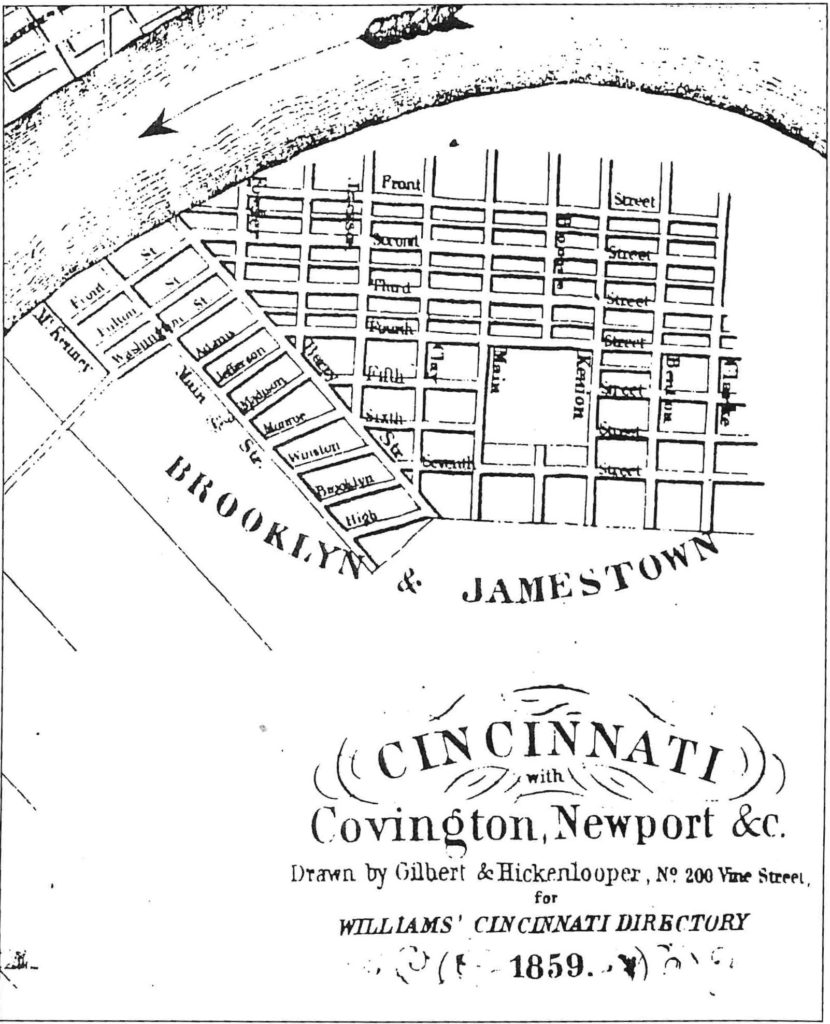
Original map of Brooklyn and Jamestown
After the Revolutionary War, in 1796, Washington Berry brought his family from Clark County, Kentucky, to the area where the City of Dayton is now located. Within a few years, more settlers arrived in this area, and on March 1, 1848, Kentucky Gov. William Owsley approved the incorporation of the City of Jamestown. The “proprietors” of the new city were James Berry, James MacArthur, and Henry Walker. Jamestown was 170 acres of land that extended from the river to the current Eighth Avenue and for seven blocks between Berry and Clark Streets.
Just under a year later, on Feb. 27, 1849, Gov. John Crittenden approved the charter of Burton Hazen and his brother — Cincinnati steamboat builders, lumber-yard owners, and real-estate developers — for a neighboring town as the City of Brooklyn. Brooklyn extended from the river to the current Eighth Avenue and from two blocks between Berry and McKinney Streets.
For nearly two decades, the two cities grew closer and closer together, and the citizens overwhelmingly voted to merge the two cities into one. On March 9, 1867, Gov. Thomas Bramlette approved the merger of the two towns into the City of Dayton.
According to an account in the July 4, 1866, issue of the Cincinnati Daily Enquirer, Dayton was named for the city in Ohio that was founded in 1803. Some county historians, though, claim the name refers to a local mill that had been built and operated by an early family in the area. A Luther Dayton was listed in Campbell County’s 1850 Census.
Industry in the City of Dayton
The Ohio River has always been an important asset and economic driver for the City of Dayton. One of its first businesses in the early 19th century was a ferry crossing on the Ohio River at the foot of the road that is now known as Dayton Pike. The City of Jamestown constructed the ferryboat John Hastings for $3,960, paid for with city-issued bonds. The ferry ran from 1853 until 1890 from the Dayton landing directly across the Ohio River to the Cincinnati shore. One of the primary purposes of the ferry was to take workers from Dayton to and from jobs at the Fulton Steamboat Company, a major builder of steamboats on the Ohio River, and other steamboat-related industries in east side of Cincinnati.
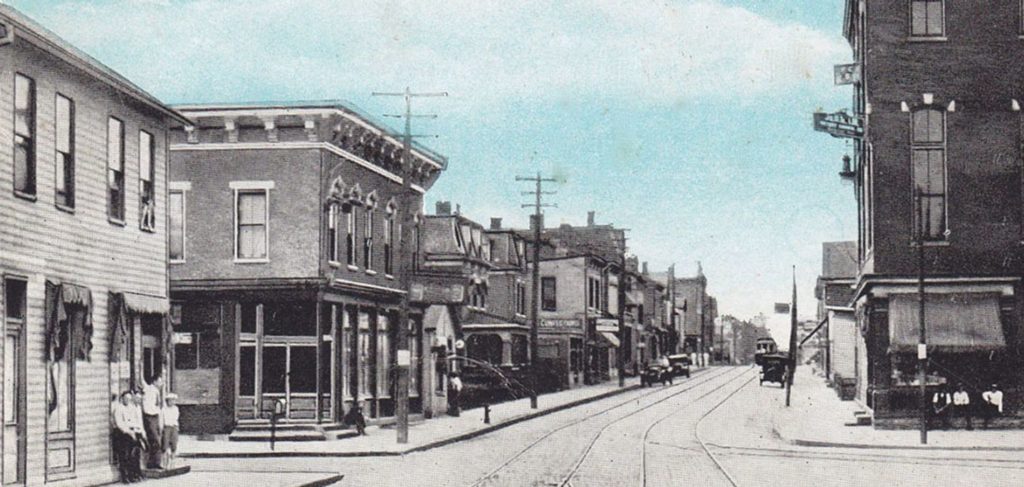
Streetcar lines on Sixth Avenue at Berry Street; Burton Hazen’s Odd Fellows Hall building is the structure on the right.
The steamboat era was the apex of industrialization in the City of Dayton, with saw and planing mills, gristmills, brickyards, tailor shops, cigar factories, and stone and sand quarries in operation. The city also was home to as many as eight ropewalks, where skilled workmen would spend their days walking backward spinning hemp yarn from coils of fiber and then making multiple passes along the length of the walk, twisting multiple strands into various weights and lengths of rope, often used on the steamboats being built in Cincinnati. Hemp was raised in large quantities in and around Dayton, and these ropewalks produced tons of rope each year.
During this same time period, Burton Hazen constructed the largest building at the northwest corner of Sixth and Berry Streets in 1884. This brick building originally housed the International Order of Odd Fellows, Dayton’s first City Hall, and other commercial uses. In 2003-2004, Orleans Development Company rehabilitated this building into commercial space on the first floor and loft-style apartments on the upper floors. Learn more about this project.
Beaches, hotels, and amusement park
The fine, clean sand that gathered as a sandbar along the Dayton riverfront — an area known to steamboat captains as the Dayton Bar and also Sandy Hook because of its shape — helped create a thriving tourist industry in the city. Dayton’s riverfront had several resort hotels at the turn of the 20th Century, including the Jamestown Hotel built by James T. Berry at the foot of Clay Street, the Union Hotel, and the Torchlight Hotel. These hotels benefited from the steamboat, tourist, and convention trade.
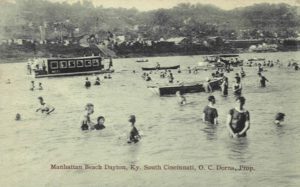
Manhattan Bathing Beach
During this time, Dayton’s Ohio River sandbar and beaches were known as the “Manhattan Bathing Beach,” a popular beach and swimming area for many years. At the height of their popularity, six different beaches operated along the Ohio River in Dayton and Bellevue.
These beaches were popular destinations for Northern Kentuckians and Cincinnatians who traveled to these attractions, first by horse and buggy, then from 1891 to 1938 by streetcar to the “end of the line” in Dayton near the beaches, and finally, by automobile and bus. After the construction of a series of dams on the river by the U.S. Army Corps of Engineers to raise the river levels to allow for consistent navigable river levels for commercial river traffic and sewage and water pollution adversely impacted the popularity of these beaches, Tony Gesser, owner of Tacoma Beach, constructed a 130-by-150 in-ground swimming pool with clean water from an artesian well that runs under the City of Dayton. This pool became part of a larger amusement park along the river.
The amusement park included a 1,000-locker bathhouse, a roller coaster, a whip ride, a merry-go-round, a penny arcade, and a combination dance floor/skating rink that previously had been an attraction at Berlin Beach in Bellevue. The Ohio River flood of 1937 destroyed much of Tacoma Park and its attractions, and the park did not recover. In 1948, much of this land was used for the Riverview Drive-in, which operated in Dayton until 1982. The site was sold and developed into the Watertown Yacht Club, which is known as the Manhattan Harbour Yacht Club and Marina.
The growth and decline of Dayton during the 20th Century
From the 1930s to the 1960s, the population of Dayton reached its zenith, with around 9,000 residents living in the river community. During this time, several large industries, including the Wadsworth Watch Case Co., Harvard Piano, and coal companies provided employment and a strong tax base for the community. As the city grew steadily, the original Sixth Street Elementary School was given to the city in 1932 because a larger school was needed. The old school building was remodeled into firemen’s quarters and city offices and a new firehouse was built next door. These buildings are still used for these purposes today, even after the second story of the school building was destroyed in a fire in 1952.
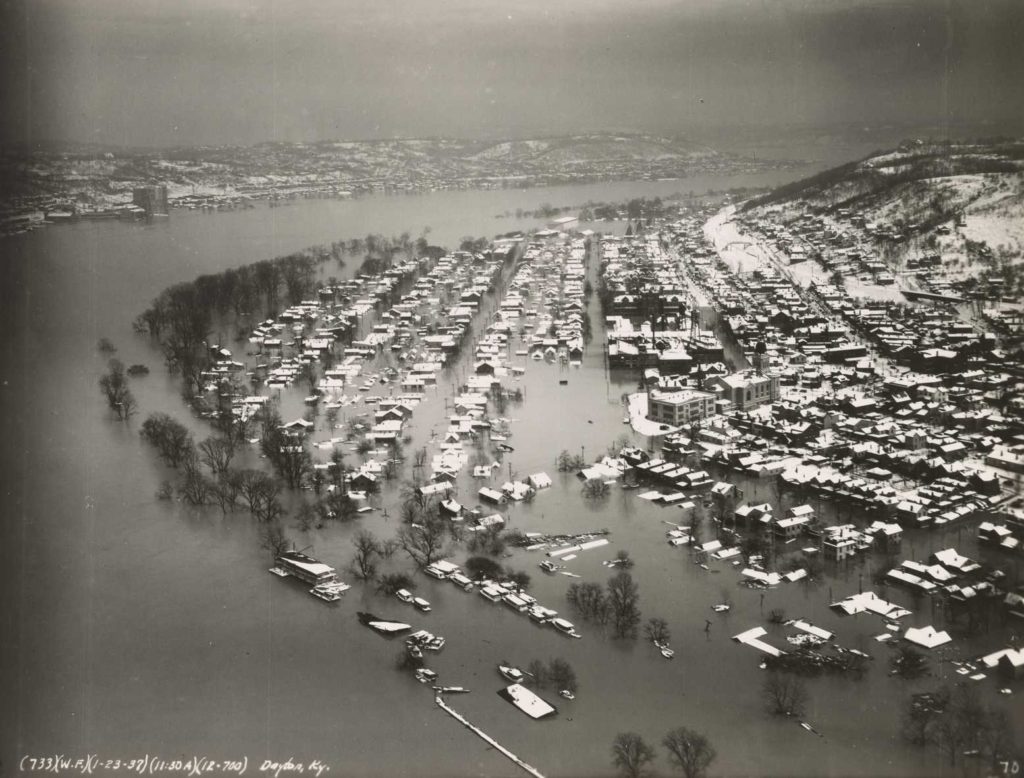
Dayton during the Great Flood of 1937
While the Ohio River has long been an important part of Dayton’s economic vitality over the years, it also has been the source of economic strife for the city as well. Floods devastated the city in 1884, 1913, and 1937, the latter of which crested at 61.3 feet (28 feet above flood stage) and destroyed 45 city blocks and damaged 450 homes, including many swept away or damaged beyond repair, affecting about 80 percent of the city’s population. These floods, especially the Great Flood of 1937, caused several of the companies operating in the once-booming city to move elsewhere. During the 1950s and 1960s, many residents — weary of the constant flooding and part of a widespread movement of urban flight to the suburbs — moved out of Dayton as well.
Thereafter, the frequently flooded homes near the Ohio River were razed in the late 1970s so the U.S. Army Corps of Engineers could construct a flood-levee system that now protects the city. The levee system was completed in late 1982 and an industrial park was constructed in the mid-to-late 1980s and 1990s to replace the razed homes on the east side of the city.
New developments along the Ohio River: Manhattan Harbour
In 2009, the City of Dayton entered into a development agreement with David Imboden, owner of DCI Properties-DKY, LLC, to develop 140 acres of city-owned property along the Ohio River as a Tax Increment Financing (TIF) District. To develop this property, the developer trucked in about 1 million cubic yards of fill to raise about 65 acres of land by about 22 feet out of the floodplain so it sits above the 100-year floodplain, a standard required by the National Flood Insurance Program.

A single-family home on Manhattan Boulevard.
Imboden later joined forces with Mark Stark, owner of Nelson Stark Construction, to continue the development of this property under the name of Manhattan Harbour Project, LLC, which currently serves as the master developer of the TIF District. This developer sold some lots at Manhattan Harbour to a subdeveloper, who is building residential units under the name of MDG One, LLC, SSCC Development, LLC, and other entities.
Manhattan Harbour started in 2015 with the construction of several luxury single-family homes along the river, which were featured that year in the Northern Kentucky Homefest, an annual residential showcase of new homes by the Northern Kentucky Homebuilders Association.
In 2020, Arlington Properties of Birmingham, Ala., developed Tapestry on the River at Manhattan Harbour, a 263-unit luxury apartment complex in four, four-story controlled-access buildings, with elevators and air-conditioned interior hallways. In 2021, Arlington Properties sold this complex to CF Riverview Multifamily DST, which changed the name Manhattan on the River.
In 2021, Gateway Flats at Manhattan Harbour, a 76-unit apartment complex with sweeping views of downtown Cincinnati and the Ohio River. Several new single-family and multi-family residential developments are expected to be constructed at Manhattan Harbour in 2022.
In 2024, Arlington Properties finished construction of its second apartment complex in the City at the east end of Manhattan Boulevard next to Manhattan Harbour Marina. The 265-unit apartment complex is known as Velo on the River.
Several new single-family and multi-family residential developments continue to be constructed in the Manhattan Harbour TIF District.

Manhattan on the River Apartments, formerly Tapestry Apartments, on the Ohio River in Manhattan Harbour development area.
